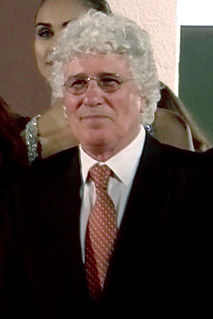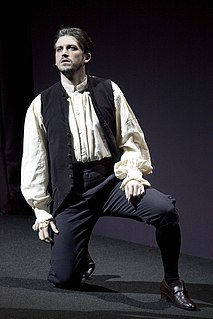Appearances in The Decameron
In each of the tales in which Calandrino is a character (VIII, 3; VIII, 6; IX, 3; IX, 5), he is portrayed as a simpleton who believes in the folk magic of the time period. In the first tale (VIII, 3), the three painters hunt for heliotropes, and Calandrino believes that by finding one he is rendered invisible. Bruno and Buffalmacco, his friends and fellow painters, pretend they don't see him and kick rocks at him all the way back to Florence, where he arrives bruised.
In the second tale (VIII, 6) Bruno and Buffalmacco subject him to a medieval version of a polygraph test. According to common belief at the time, a person who is lying wouldn't be able to swallow the prepared bread and cheese when under examination. However, Bruno and Buffalmacco sour the cheese with dog ginger, a very bitter herb which Calandrino then spits out. This convinces his friends that he is lying about a pig of his being stolen (which in reality they had taken).
Calandrino is convinced that he is pregnant in story IX, 3. To give him a painless miscarriage he takes a potion that is specially prepared by his friends, Bruno and Buffalmacco.
Finally, tale IX, 5 is a story in which Boccaccio uses the Calandrino character to ridicule the folk magic of his time period. To gain a woman's affections, Calandrino casts a spell and prepares a potion from a scroll supplied by Bruno. The potion contains all sorts of absurd ingredients and the scroll is filled with gibberish. When his wife discovers his intentions, she beats Calandrino.

Giovanni Boccaccio was an Italian writer, poet, correspondent of Petrarch, and an important Renaissance humanist. He was known par excellence as the Certaldese, and one of the most important figures in the European literary panorama of the fourteenth century. Some scholars define him as the greatest European prose writer of his time, a versatile writer who amalgamated different literary trends and genres, making them converge in original works, thanks to a creative activity exercised under the banner of experimentalism.

This article contains summaries and commentaries of the 100 stories within Giovanni Boccaccio's The Decameron.

Buonamico di [son of] Martino or Buonamico Buffalmacco was an Italian painter who worked in Florence, Bologna and Pisa. Although none of his known work has survived, he is widely assumed to be the painter of a most influential fresco cycle in the Camposanto in Pisa, featuring The Three Dead and the Three Living, the Triumph of Death, the Last Judgement, the Hell, and the Thebais. Painted some ten years before the Black Death spread over Europe in 1348, the cycle - a "painted sermon" - enjoyed an extraordinary success after that date, and was often imitated throughout Italy. The youngsters' party enjoying themselves in a beautiful garden while Death piles mounds of corpses all around is likely to have inspired the setting of Giovanni Boccaccio's Decameron, written a few years after the Black Death.
"The Merchant's Tale" is one of Geoffrey Chaucer's Canterbury Tales. In it Chaucer subtly mocks antifeminist literature like that of Theophrastus ('Theofraste'). The tale also shows the influence of Boccaccio, Deschamps' Le Miroir de Mariage, Roman de la Rose by Guillaume de Lorris, Andreas Capellanus, Statius and Cato. The tale is found in Persia in the Bahar Danush, in which the husband climbs a date tree instead of a pear tree. It could have arrived in Europe through the One Thousand and One Nights, or perhaps the version in book VI of the Masnavi by Rumi. Though several of the tales are sexually explicit by modern standards, this one is especially so. Larry Benson remarks:

Giuseppe Gazzaniga was a member of the Neapolitan school of opera composers. He composed fifty-one operas and is considered to be one of the last Italian opera buffa composers.

Boccaccio, oder Der Prinz von Palermo is an operetta in three acts by Franz von Suppé to a German libretto by Camillo Walzel and Richard Genée, based on the play by Jean-François Bayard, Adolphe de Leuven, Léon Lévy Brunswick and Arthur de Beauplan, based in turn on The Decameron by Giovanni Boccaccio.

Calandro is an opera buffa in three acts composed by Giovanni Alberto Ristori to a libretto by Stefano Benedetto Pallavicino. The libretto was based on the comedy Il Calandro by Bernardo Dovizi. In turn, Dovizi's play borrowed elements of the plot from Plautus's Menaechmi and the character Calandro from Boccaccio's Decameron It was first staged on 2 September 1726 in Dresden.

Bernardo Dovizi of Bibbiena was an Italian cardinal and comedy writer, known best as Cardinal Bibbiena, for the town of Bibbiena, where he was born.

The Decameron is a 1971 film by Italian director Pier Paolo Pasolini, based on the novel Il Decameron by Giovanni Boccaccio. It is the first movie of Pasolini's Trilogy of life, the others being The Canterbury Tales and Arabian Nights. Each film was an adaptation of a different piece of classical literature focusing on ribald and often irreligious themes.

Giovanni "Ninetto" Davoli is an Italian actor who became known through his roles in several of Pier Paolo Pasolini's films.

Griselda is a figure in European folklore noted for her patience and obedience.

Maria d'Aquino was a Neapolitan noblewoman who is traditionally identified with Giovanni Boccaccio's beloved and muse Fiammetta.

The Decameron, subtitled Prince Galehaut and sometimes nicknamed l'Umana commedia, is a collection of novellas by the 14th-century Italian author Giovanni Boccaccio (1313–1375). The book is structured as a frame story containing 100 tales told by a group of seven young women and three young men; they shelter in a secluded villa just outside Florence in order to escape the Black Death, which was afflicting the city. Boccaccio probably conceived of The Decameron after the epidemic of 1348, and completed it by 1353. The various tales of love in The Decameron range from the erotic to the tragic. Tales of wit, practical jokes, and life lessons contribute to the mosaic. In addition to its literary value and widespread influence, it provides a document of life at the time. Written in the vernacular of the Florentine language, it is considered a masterpiece of classical early Italian prose.
Il Corbaccio, or "The Crow", is an Italian literary work by Giovanni Boccaccio, traditionally dated c. 1355.

Decameron Nights is a 1953 anthology Technicolor film based on three tales from The Decameron by Giovanni Boccaccio, specifically the ninth and tenth tales of the second day and the ninth tale of the third. It stars Joan Fontaine and, as Boccaccio, Louis Jourdan.

Juan Francisco Gatell (born November 28, 1978 in La Plata, Argentina Juan Francisco Gatell is an Argentinian operatic tenor who specialises in the bel canto repertoire.

The Story of Nastagio Degli Onesti, part one is a painting in tempera on wood by Sandro Botticelli, dated 1483. It measures 83 x 138 cm and is in the Prado in Madrid.

Wondrous Boccaccio is a 2015 Italian film directed by Paolo and Vittorio Taviani. It is loosely based on stories from The Decameron by Giovanni Boccaccio.

Boccaccio is a 1972 Italian comedy film written and directed by Bruno Corbucci. It is loosely based on the Giovanni Boccaccio's novel Decameron, and it is part of a series of derivative comedies based on the success of Pier Paolo Pasolini's The Decameron (1971).

Corrado Malaspina, was an Italian nobleman and landowner.

















